The Most Recognized Gold and Silver Bullion Coins
Investing in precious metals through bullion coins is one of the most accessible and popular ways to diversify a portfolio. Bullion coins combine intrinsic value, historical appeal, and global recognition, making them a trusted choice for both seasoned investors and newcomers. Unlike bars, bullion coins offer unique advantages: they are highly divisible (easier to buy/sell in smaller quantities), often carry legal tender status (enhancing liquidity), and sometimes hold collectible or numismatic value due to their designs and historical significance. Governments and mints worldwide guarantee their weight, purity, and authenticity, adding a layer of security.
However, bullion coins do have minor drawbacks. They typically trade at slightly higher premiums over spot prices compared to bars due to production costs and design intricacy. Storage can also become a consideration for large quantities, though their compact size makes them easier to secure than bulkier bars. Even with these slight trade-offs, bullion coins continue to stand out as a dependable option for investors looking to preserve wealth and hedge against economic volatility.
TOP 10 GOLD BULLIONS COINS
Gold coins have a storied history, serving as both currency and a store of value for centuries. From ancient civilizations minting gold coins for trade to modern nations producing them for investment purposes, gold coins have been integral to economic systems worldwide. In today’s market, gold bullion coins generally fall into two categories based on their composition:
Pure Gold Coins (24-karat, .9999 fine): These coins, such as the Canadian Gold Maple Leaf and the American Gold Buffalo, are made of nearly pure gold. Their high purity makes them appealing to investors seeking maximum gold content.
Gold Alloy Coins (22-karat, .9167 fine): Coins like the South African Krugerrand and the American Gold Eagle are composed of gold mixed with small amounts of other metals, such as copper or silver. This alloy increases durability, making the coins more resistant to scratches and wear.
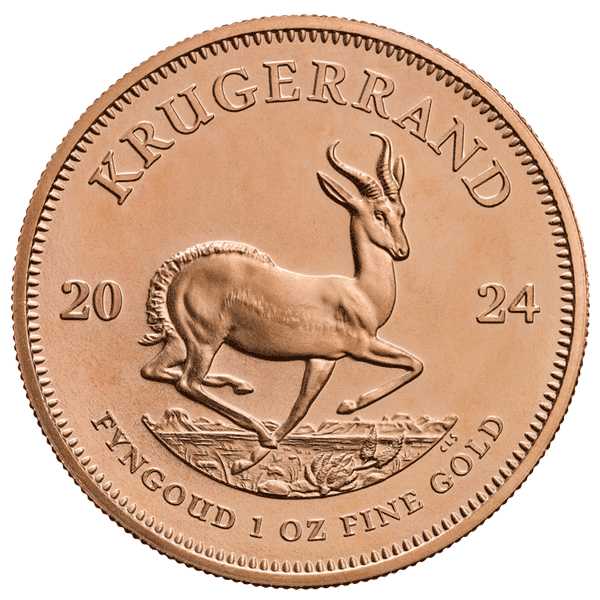
#1 - SOUTH AFRICAN KRUGERRAND
First minted in 1967 by the South African Mint and Rand Refinery to promote private ownership of South African gold, the Krugerrand quickly became the world’s most popular bullion coin, accounting for over 90% of global gold coin sales by 1980. Named after President Paul Kruger and the South African currency, the rand, the coin features Kruger’s portrait on the obverse, designed by Otto Schultz, and a springbok antelope on the reverse, created by Coert Steynberg. Struck in 22-karat gold (91.67% gold, 8.33% copper) for added durability and a distinctive warm tone, the Krugerrand remains legal tender, though it carries no face value under the South African Reserve Bank Act of 1989. The standard 1 oz version weighs 33.93 g, measures 32.77 mm in diameter, and is 2.84 mm thick; fractional sizes of 1/10, 1/4, and 1/2 troy oz were introduced in 1980.
Manufacturer: South African Mint
Purity: 91.67%
Sizes: 1/10 troy oz, 1/4 troy oz, 1/2 troy oz, 1 troy oz, 2 troy oz
Years minted: 1967-present
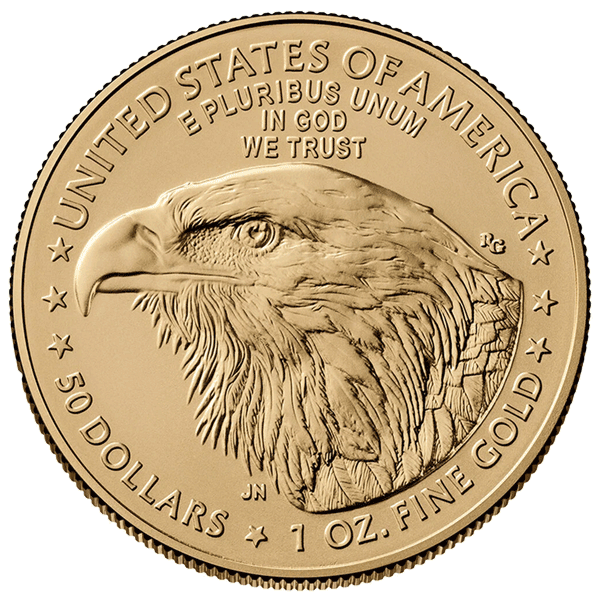
#2 - AMERICAN GOLD EAGLE
The American Gold Eagle, authorized by the Gold Bullion Coin Act of 1985 and first issued by the U.S. Mint in 1986, is one of the world’s most recognized and widely traded gold bullion coins. The obverse features Augustus Saint-Gaudens’ iconic 1907 Liberty design, originally created for the $20 Double Eagle. From 1986 to 2020, the reverse featured a family of eagles by Miley Busiek, replaced in 2021 by a striking bald eagle profile designed by Jennie Norris. Struck in a durable 22-karat “crown gold” alloy (91.67% gold, 3% silver, and 5.33% copper), the coin resists wear while retaining one full troy ounce (31.1035 g) of pure gold. The 1 oz coin has a gross weight of 33.931 g, a diameter of 32.70 mm, a thickness of 2.87 mm, and a reeded edge. Legal tender with a face value of $50, the Gold Eagle is also available in fractional sizes of 1/2, 1/4, and 1/10 troy oz, each featuring the same iconic designs. Backed by the U.S. government for weight and purity, the Gold Eagle remains one of the most trusted and widely traded bullion coins in the world.
Manufacturer: United States Mint
Purity: 91.67%
Sizes: 1/10 troy oz, 1/4 troy oz, 1/2 troy oz, 1 troy oz
Years minted: 1986-present
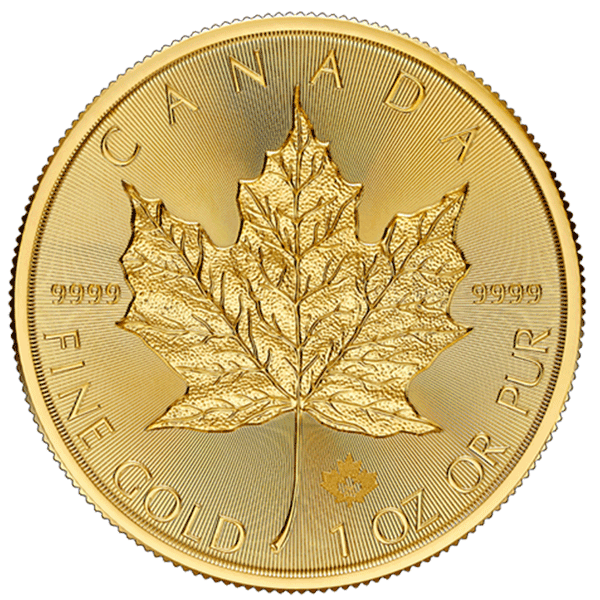
#3 - CANADIAN MAPLE LEAF
The Canadian Gold Maple Leaf, introduced by the Royal Canadian Mint in 1979, was developed to provide a high-purity alternative to the South African Krugerrand amid global boycotts. Initially struck in .999 fine gold, it was upgraded in 1982 to .9999 purity, making it the world’s first 24-karat bullion coin of such fineness. Legal tender with a face value of CAD $50, it features the reigning monarch’s effigy on the obverse, Queen Elizabeth II until 2023, and now King Charles III, paired with Walter Ott’s iconic maple leaf design on the reverse. The standard 1 oz coin contains 31.11 g of .9999 fine gold, measures 30.00 mm in diameter with a reeded edge, and is known for its exceptional finish and security features, including radial lines and a micro-engraved maple leaf introduced in 2013. Fractional sizes include 1 g, 1/20, 1/10, 1/4, and 1/2 troy oz, offering flexibility for investors at various levels. Globally recognized for its purity, quality, and anti-counterfeiting innovations, the Gold Maple Leaf remains one of the most trusted and widely traded bullion coins in the world.
Manufacturer: Royal Canadian Mint
Purity: 99.99%
Sizes: 1 gram, 1/20 troy oz, 1/10 troy oz, 1/4 troy oz, 1/2 troy oz, 1 troy oz
Years minted: 1979-present
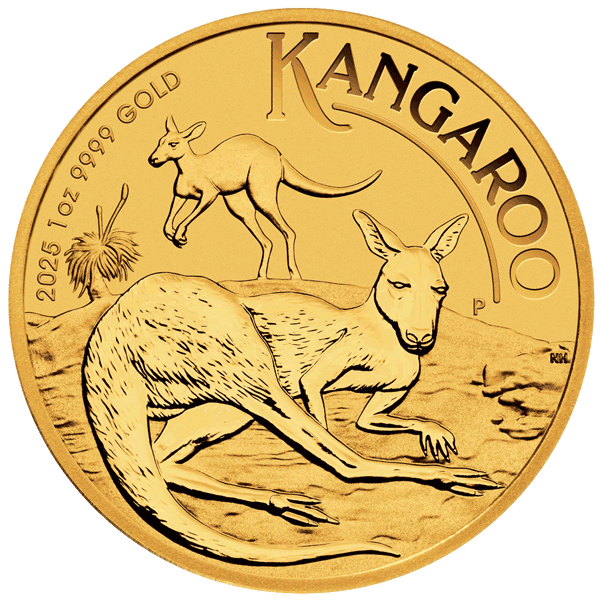
#4 - AUSTRALIAN KANGAROO
The Australian Gold Kangaroo was first issued by the Perth Mint in 1986 as the Gold Nugget, featuring images of famous gold nuggets. In 1990, the series adopted annually changing kangaroo designs, a symbol instantly associated with Australia. Struck in .9999 fine (24-karat) gold, the 1 troy oz coin contains 31.103 g of pure gold, measures 32.10 mm in diameter, 2.65 mm in thickness, and carries a face value of AUD $100. Fractional sizes (1/20, 1/10, 1/4, and 1/2 troy oz) and larger formats (2 troy oz, 5 troy oz, and 1 kg) are also available. In 2011, the series even introduced a 1-tonne coin—recognized by Guinness World Records as the largest and heaviest gold coin ever struck, containing over 32,000 ounces of gold. Legal tender and encapsulated at the mint, the Gold Kangaroo is valued for its high purity, annually updated designs, and strong global recognition.
Manufacturer: Perth Mint
Purity: 99.99%
Sizes: 1/20 troy oz, 1/10 troy oz, 1/4 troy oz, 1/2 troy oz, 1 troy oz, 2 troy oz, 5 troy oz, 1 kg
Years minted: 1986-present
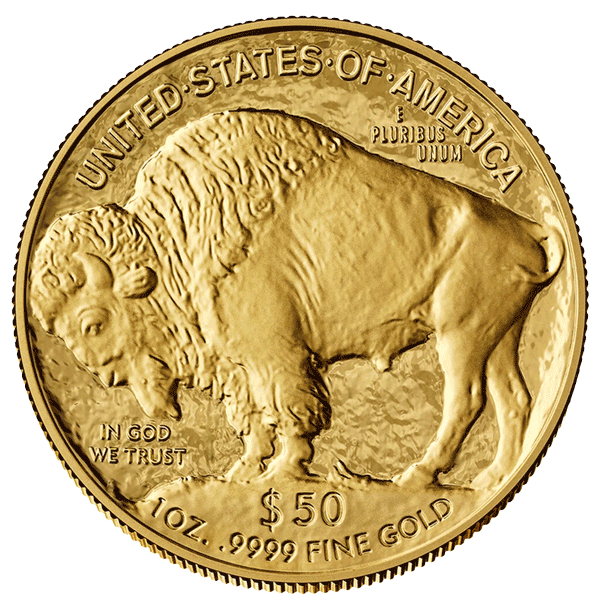
#5 - AMERICAN BUFFALO
The American Buffalo, also known as the Gold Buffalo, is a 24-karat gold bullion coin first issued by the United States Mint on June 22, 2006, under the authority of the Presidential $1 Coin Act of 2005. It was the first U.S. coin to be struck in .9999 fine gold, containing one troy ounce (31.1035 g) of pure gold and carrying a legal tender face value of $50. Its obverse features a modern adaptation of James Earle Fraser’s 1913 Indian Head nickel, depicting a Native American portrait. The reverse displays Fraser’s iconic American bison, reportedly based on “Black Diamond,” a buffalo once housed at the Central Park Zoo. The 32.70 mm diameter and 2.95 mm thickness give it a classic heft appreciated by investors and collectors alike. While the 1 oz bullion version remains the standard and dominant format, the U.S. Mint also issued fractional sizes (1/2, 1/4, and 1/10 troy oz) in 2008. The coin’s reeded edge and historic design have made it a popular hedge against inflation and a centerpiece of bullion holdings.
Manufacturer: United States Mint
Purity: 99.99%
Sizes: 1 troy oz
Years minted: 2006-present

#6 - BRITISH BRITANNIA
The British Gold Britannia coin is a bullion piece issued by the Royal Mint since 1987 and named after the female personification of the United Kingdom, Britannia, who has appeared on British coinage for centuries. Initially struck in 22-karat gold and weighing 34.05 g to deliver exactly one troy ounce of pure gold, the coin was reissued in 2013 as a 24-karat (.9999 fine) version, weighing 31.10 g and carrying a face value of £100. The obverse features the monarch’s effigy, Queen Elizabeth II until 2022 and now King Charles III, while the reverse showcases Philip Nathan’s timeless portrayal of Britannia holding a trident and shield. The coin measures 32.69 mm in diameter and 2.69 mm thick, with a reeded edge for security and tactile appeal. Fractional sizes (1/2, 1/4, 1/10, 1/20 oz) were introduced to broaden investor access, each carrying a proportional face value (£50, £25, £10, £5) and retaining the same iconic design.
Manufacturer: Royal Mint
Purity: 99.99%
Sizes: 1/10 troy oz, 1/4 troy oz, 1/2 troy oz, 1 troy oz
Years minted: 1987-present

#7 - CHINESE PANDA
The Chinese Gold Panda series, first issued by the Official Mint of the People’s Republic of China in 1982, is renowned for its annually changing reverse designs featuring different panda illustrations, paired with a consistent obverse depiction of the Temple of Heaven. Originally minted in various troy-ounce sizes of .999 fine gold, the series adopted metric weights in 2016. The 30 g coin carries a face value of 500 yuan, has a total weight of 31.10 g, measures 32.05 mm in diameter and 2.70 mm in thickness, and is struck in .999 fine gold. Unique among bullion coins, the Panda’s annually changing design attracts collectors, with the only reverse repetition occurring in 2001–02 due to popular demand. No mint marks are used, though minor design variations at the Beijing, Shanghai, Shenyang, and Shenzhen mints allow experts to identify their origin. Today, the Gold Panda remains legal tender and a global collector favorite, valued for both its artistic appeal and bullion content.
Manufacturer: The Chinese Mint
Purity: 99.9%
Sizes:1 g, 3 g, 8 g, 15 g, 30 g, 50 g, 150 g
Years minted: 1982-present

#8 - AUSTRIAN PHILHARMONIC
The Vienna Philharmonic gold coin, produced by the Austrian Mint since October 1989, is named for Vienna’s world-renowned orchestra, whose pipe organ adorns the obverse and whose instruments grace the reverse. The one-ounce bullion coin contains 31.103 grams of .9999 fine (24-karat) gold. It has a face value of €100 (formerly 2,000 schillings), a diameter of 37.00 mm, a thickness of 2.00 mm, and a smooth edge. Fractional sizes of 1/25 troy oz, 1/10 troy oz, 1/4 troy oz, and 1/2 troy oz were added in 1991 and 2013, all sharing the same timeless design. The annual mintage varies in response to market demand, reflecting the coin’s popularity. By 2012, sales had surpassed 14 million ounces of gold, making it one of the world’s best-selling gold coins, especially in Europe and Japan. In addition to gold, the Philharmonic series includes silver (.999 fine since 2008) and platinum (.9995 fine since 2016) versions, each featuring the same designs.
Manufacturer: Austrian Mint
Purity: 99.99%
Sizes: 1/25 troy oz, 1/10 troy oz, 1/4 troy oz, 1/2 troy oz, 1 troy oz
Years minted: 1989-present
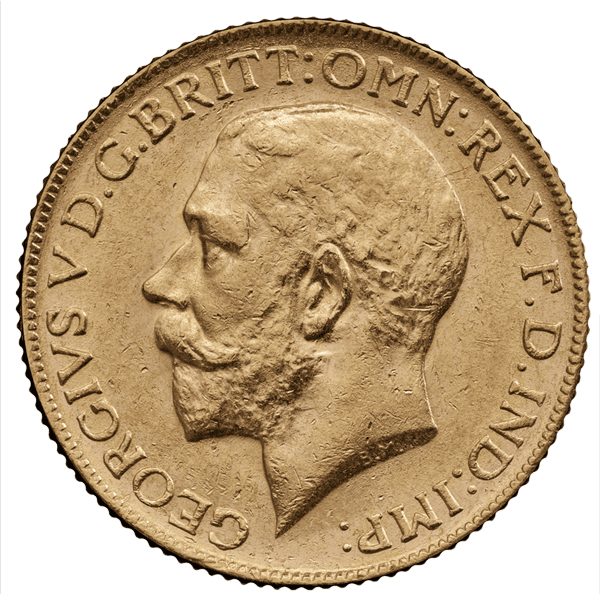
#9 - BRITISH SOVEREIGN
The British gold sovereign was first struck in 1817 as part of the Great Recoinage. It replaced the guinea as Britain’s primary circulating gold coin, valued at exactly one pound sterling, and helped restore public confidence in the nation’s currency following the Napoleonic Wars. Designed by Benedetto Pistrucci in 1817, its obverse traditionally bears the monarch’s profile (currently King Charles III) and its reverse features the famed St. George and the Dragon motif. Weighing 7.988 g with 7.3224 g (0.2354 troy oz) of fine gold, it is struck in 22 kt (91.67% Au) with copper added for durability. The coin measures 22.05 mm in diameter and 1.52 mm thick; a half-sovereign (3.994 g, 19.30 × 1.52 mm) was also issued for everyday use. Today the Sovereign is prized by collectors and investors alike for its rich heritage and recognizability.
Manufacturer: The Royal Mint
Purity: 91.67%
Sizes: 1.83 g, 3.66 g, 7.32 g, 14.63 g, 36.61 g
Years minted: 1817-present
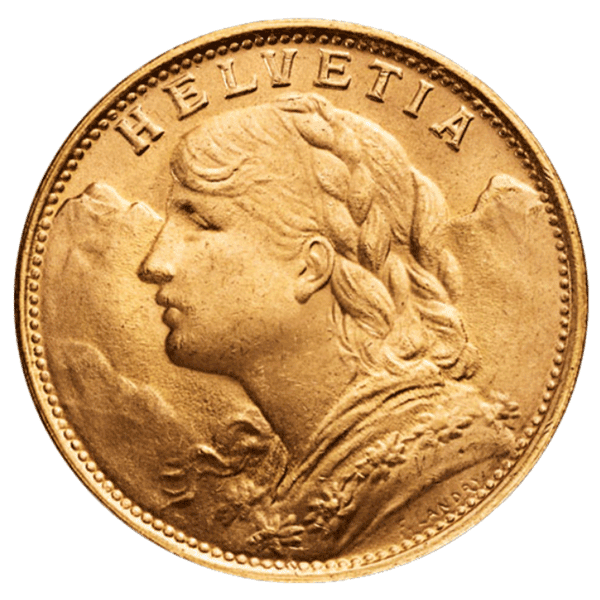
#10 - SWITZERLAND VRENELI
The Swiss “Vreneli,” officially a 20-franc gold coin, debuted in 1897 under the Latin Monetary Union standards and remained in production until 1949. Its obverse depicts the allegorical female figure “Vreneli” (an informal name for Veronica) wearing a wreath of Alpine flowers, while the reverse shows the Swiss shield and wreath. Struck in 90% gold with 10% copper, the standard 20 franc Vreneli contains 0.1867 troy oz (5.806 g) of pure gold, measures 21.2 mm in diameter, and is 1.4 mm thick. Apart from the 20 franc, 10 franc (1911–22) and special 100 franc (1925) issues share the same purity and alloy. Today Vrenelis remain favored for their classic design and historical appeal.
Manufacturer: Swissmint
Purity: 90%
Sizes: 2.9 g, 5.81 g, 29.03 g
Years minted: 1897 to 1936 (+1947 & 1949)
TOP 10 SILVER BULLIONS COINS
Silver bullion coins offer a cost-effective gateway into precious metal investing, combining affordability with the same government-backed assurance as gold. Historically, silver coins circulated as currency, but modern iterations prioritize investment value. The 1986 launch of the American Silver Eagle marked a turning point, inspiring mints worldwide to produce high-purity silver coins (often 99.9% pure or higher).
While silver trades at a fraction of gold’s price, its industrial demand and role as a monetary metal create unique market dynamics. Silver coins are bulkier than gold due to the metal’s lower density, but their smaller denominations allow incremental investing. Some coins, like the Canadian Silver Maple Leaf, prioritize purity, while others, such as the Austrian Philharmonic, celebrate cultural heritage through intricate designs. Below, discover the 10 most popular silver bullion coins, ideal for balancing portfolio risk, capitalizing on silver’s volatility, or owning a piece of minting artistry.
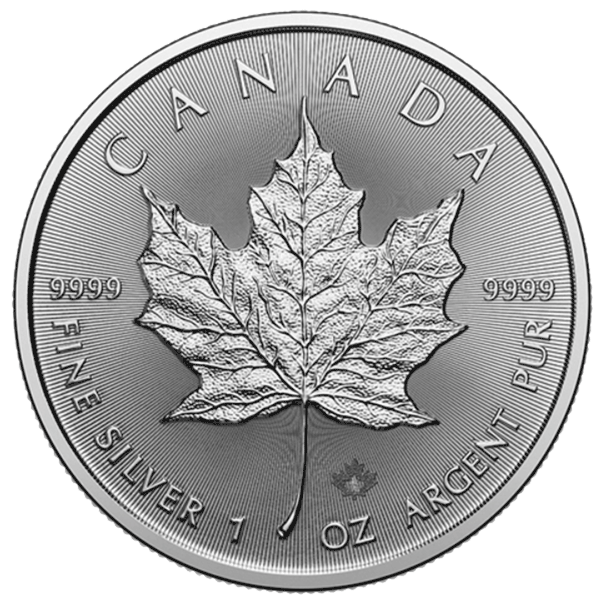
#1 - SILVER MAPLE LEAF
Introduced by the Royal Canadian Mint in 1988, the Canadian Silver Maple Leaf is Canada’s signature silver bullion coin and carries a face value of CAD 5. Its obverse features the reigning monarch’s effigy (Queen Elizabeth II until 2022, now King Charles III), while the reverse showcases Walter Ott’s iconic single maple leaf design. The standard issue contains 1 troy ounce (31.10 g) of .9999-fine silver, making it one of the purest government-backed silver coins in the world. It measures 38 mm in diameter with a reeded edge. The Royal Canadian Mint has issued limited collector editions of the Silver Maple Leaf with a ‘W’ mint mark from its Winnipeg facility, while the standard bullion version continues to be produced at its Ottawa facility.
Manufacturer: Royal Canadian Mint
Purity: 99.99%
Sizes: 1/2 troy oz, 1 troy oz, 5 troy oz, 10 troy oz
Years minted: 1988-present
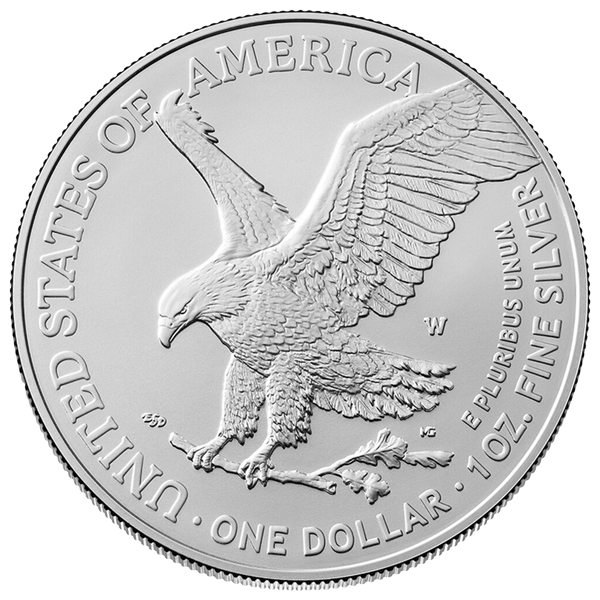
#2 - SILVER EAGLE
The American Silver Eagle, first released November 24, 1986 under the Liberty Coin Act, is the official silver bullion coin of the United States. The obverse features Adolph A. Weinman’s iconic 1916 Walking Liberty design, while the reverse, designed by John M. Mercanti, depicts a heraldic eagle with a shield. Each coin contains exactly 1 troy ounce (31.10 g) of .999‑fine silver (with 0.07% copper trace for durability), measures 40.60 mm in diameter, and is 2.98 mm thick. With a legal tender value of $1 USD, the Silver Eagle is highly liquid and widely favored by investors as both a store of value and a collectible. It is also available in Proof and Burnished finishes.
Manufacturer: United States Mint
Purity: 99.9%
Sizes: 1 troy oz
Years minted: 1986-present
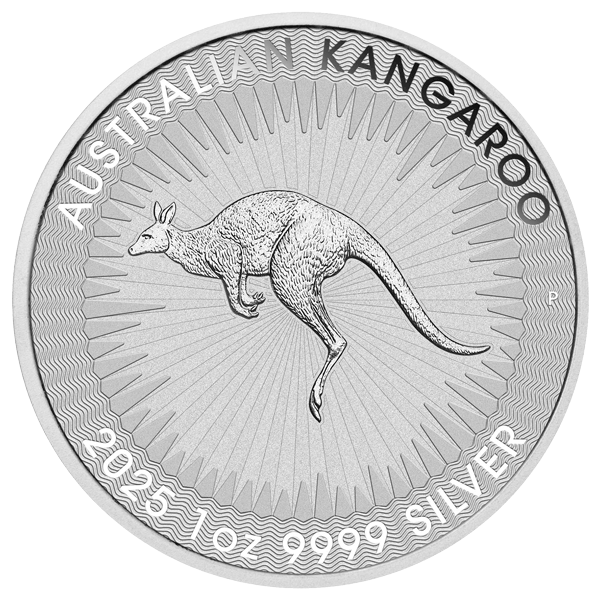
#3 - SILVER KANGAROO
Introduced in 2015 by the Perth Mint as Australia’s premier silver bullion coin, the Silver Kangaroo aims to complement the Gold Kangaroo series and meet investor demand for high-purity silver. Struck in 99.99% silver, each one-ounce (31.103 g) coin measures 40.60 mm in diameter and 3.20 mm in thickness, with a reeded edge for security. The obverse bears Jody Clark’s 2015 effigy of Queen Elizabeth II, while the reverse features Dr. Stuart Devlin’s red kangaroo in mid-leap, a design first used in the gold series and adapted here for silver. With unlimited bullion mintage, it is available in both uncirculated and proof finishes, making it a versatile addition for investors and collectors alike.
Manufacturer: Perth Mint
Purity: 99.99%
Sizes: 1 troy oz
Years minted: 2016-present

#4 - SILVER BRITANNIA
Launched by the Royal Mint in 1997 to capitalize on the success of the gold Britannia, the Silver Britannia initially featured .958-fine silver before upgrading to .999 fineness in 2013. The 2013-onward bullion issue weighs 31.21 g (31.10 g fine silver), measures 38.61 mm in diameter, and carries a face value of £2 (formerly £1) as legal tender in the UK. Its obverse displays Ian Rank-Broadley’s effigy of Queen Elizabeth II (now King Charles III), while the reverse showcases Philip Nathan’s modern Britannia, complete with trident, shield, and flowing robes. Fractional sizes (1/2, 1/4, 1/10 troy oz) were introduced alongside the bullion release to broaden investor access.
Manufacturer: Royal Mint
Purity: 99.9%
Sizes: 1/10 troy oz, 1/4 troy oz, 1/2 troy oz, 1 troy oz, 2 troy oz, 5 troy oz, 10 troy oz, 1 kg
Years minted: 1997-present
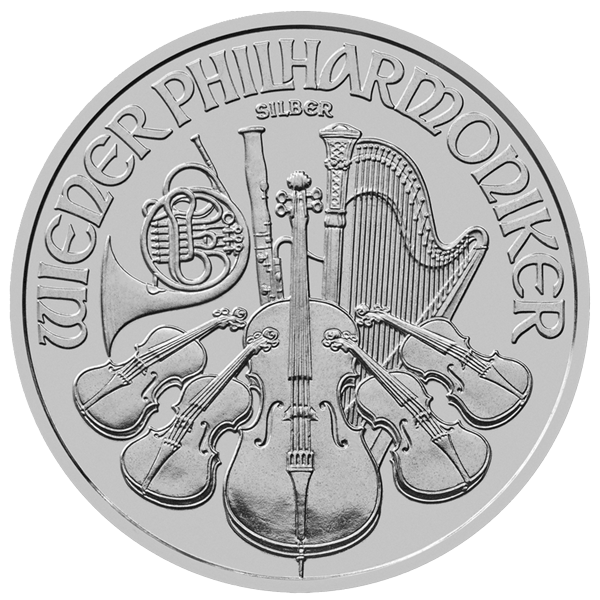
#5 - SILVER PHILHARMONICS
Austria’s Silver Philharmonic, first released in Europe in 2008, is the official silver bullion coin of the Republic of Austria and carries a face value of €1.50. Struck from .999 fine silver, each coin contains 1 troy ounce (31.103 g) of silver and measures 37 mm in diameter and 3.2 mm in thickness, with a smooth edge that sets it apart from many other bullion coins. The obverse features the pipe organ of Vienna’s Musikverein, while the reverse depicts a collection of Philharmonic instruments including the violin, cello, harp, bassoon, and horn, celebrating Austria’s rich musical heritage. Its consistent design and broad acceptance have helped make it one of Europe’s best-selling silver bullion coins.
Manufacturer: Austrian Mint
Purity: 99.9%
Sizes: 1 troy oz
Years minted: 2008-present
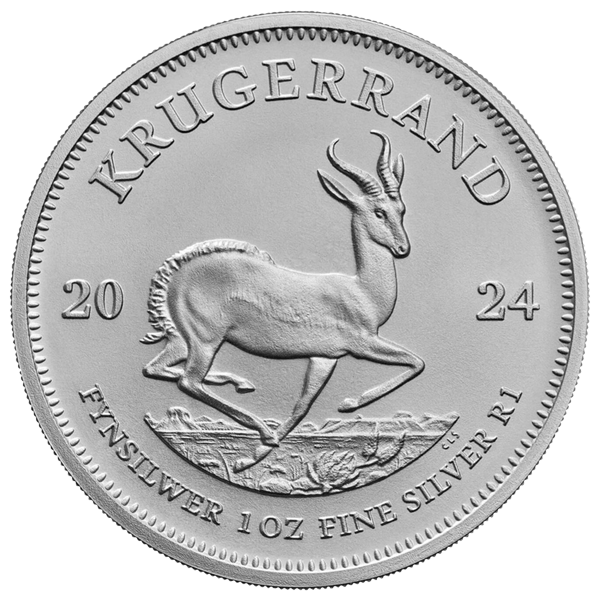
#6 - SILVER KRUGERRAND
In response to growing demand for silver bullion, the South African Mint introduced the Silver Krugerrand in 2017, following the format of the iconic gold version. Each coin contains one troy ounce (31.103 g) of 99.9% silver, measures 32.77 mm in diameter and approximately 2.84 mm thick, and features a reeded edge for added security. The obverse retains Otto Schulz’s portrait of President Paul Kruger, while the reverse displays Coert Steynberg’s pronking springbok, designs unchanged from the 1967 gold issue, providing instant recognition and continuity. Designated as legal tender with a face value of 1 Rand, the Silver Krugerrand enjoys the credibility of sovereign issue alongside its intrinsic silver value.
Manufacturer: South African Mint
Purity: 99.9%
Sizes: 1 troy oz, 2 troy oz, 5 troy oz
Years minted: 2017-present

#7 - SILVER PANDAS
The Silver Panda series debuted in 1983 as a proof issue one year after the Gold Panda’s launch, with 10,000 proof coins struck at American request. From 1989 onward, bullion Silver Pandas became available to investors, featuring annually rotating panda designs and the Temple of Heaven obverse. All coins are guaranteed by the People’s Bank of China and struck in .999 fine silver. Originally issued in troy-ounce sizes, the series switched to metric weights in 2016, with the standard one-ounce coin now 30 g and 40 mm in diameter. Collectors prize the annual design changes, making Pandas both bullion and numismatic favorites.
Manufacturer: The Chinese Mint
Purity: 99.9%
Sizes: 30 g, 150 g, 1 kg
Years minted: 1983-present
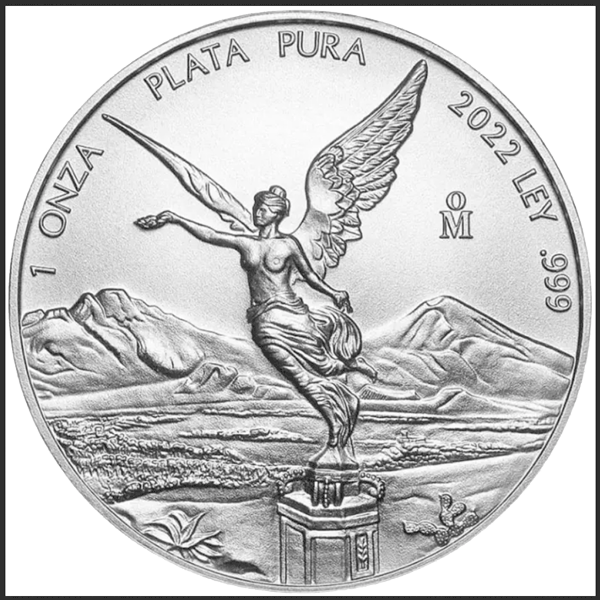
#8 - SILVER LIBERTADS
First issued in 1982 by the Casa de Moneda de México, the Silver Libertad draws on the iconic 1921 Centenario gold coin reverse, celebrating Mexican independence with the Winged Victory statue. The obverse displays Mexico’s national coat of arms surrounded by historical eagle emblems. Bullion Libertads contain one troy ounce (31.10 g) of .999 fine silver, measure 40 mm in diameter, and are 3 mm thick with a reeded edge. Fractional sizes (1/2, 1/4, 1/10, 1/20 troy oz) were added in 1991 to broaden access. Legal tender but valued for metal content, Libertads remain among the world’s most sought-after silver coins.
Manufacturer: Casa de Moneda
Purity: 99.9%
Sizes: 1/20 troy oz, 1/10 troy oz, 1/4 troy oz, 1/2 troy oz, 1 troy oz, 2 troy oz, 5 troy oz, 1 kg
Years minted: 1982-present

#9 - MORGAN SILVER DOLLARS
The Morgan Silver Dollar, struck from 1878 to 1904 and again briefly in 1921, marked the United States’ return to silver coinage following the Coinage Act of 1873. Named for its designer, George T. Morgan, the coin remains a historic icon. Its obverse depicts Lady Liberty’s profile in a Phrygian cap, while the reverse shows a heraldic eagle clutching arrows and olive branch. Each contains 0.7734 troy oz of pure silver (90% Ag, 10% Cu), weighs 26.73 g total, and measures 38.10 mm in diameter by 2.40 mm thick with a reeded edge. Highly collectible today, Morgan Dollars are prized for their historic artistry and silver content.
Manufacturer: United States Mint
Purity: 99.9%
Sizes: 0.77344 troy oz
Years minted: 1878 to 1904 (+1921 & 2021)
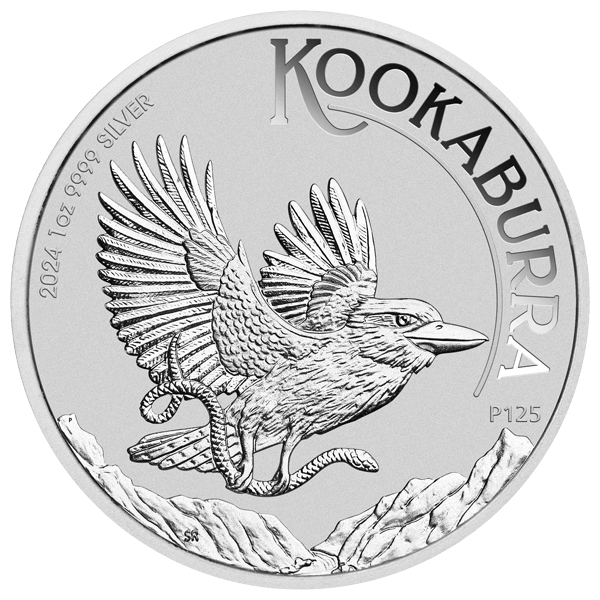
#10 - SILVER KOOKABURRAS
Introduced by the Perth Mint in 1990, the Silver Kookaburra complements Australia’s silver bullion lineup with annually changing reverse designs of the native kookaburra bird. Struck initially in .999 fine silver and upgraded to .9999 in 2018, the standard one-ounce coin contains 31.135 g of silver, measures 40.60 mm in diameter and 2.98 mm thick, with a slanted-reeded edge. The obverse bears Jody Clark’s effigy of Queen Elizabeth II (now King Charles III), while the reverse artists change annually, enhancing collectibility. Bullion and proof finishes are available, making it popular among investors and collectors alike.
Manufacturer: Perth Mint
Purity: 99.99%
Sizes: 1 troy oz, 2 troy oz, 5 troy oz, 10 troy oz, 1 kg
Years minted: 1990-present
